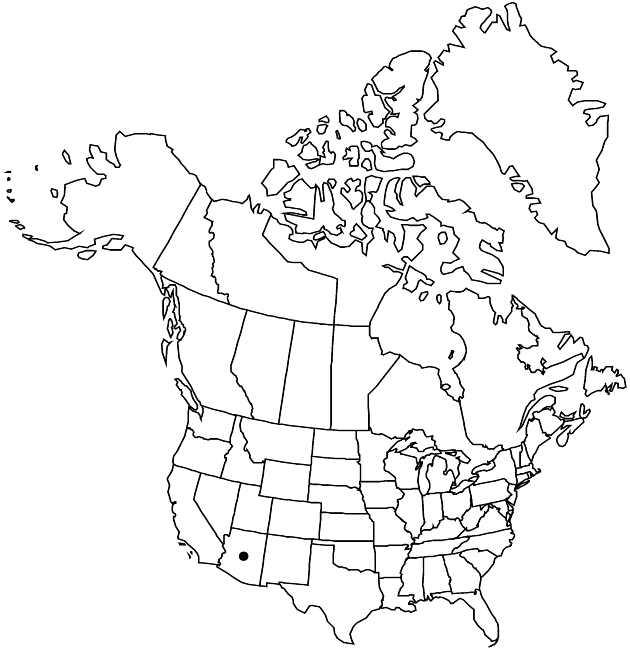Difference between revisions of "Lorandersonia salicina"
Sida 21: 1624. 2005.
FNA>Volume Importer |
GeoffLevin (talk | contribs) m (Corrected accepted name authorities to match printed version) |
||
| (7 intermediate revisions by 2 users not shown) | |||
| Line 1: | Line 1: | ||
{{Treatment/ID | {{Treatment/ID | ||
|accepted_name=Lorandersonia salicina | |accepted_name=Lorandersonia salicina | ||
| − | |accepted_authority=(S. F. Blake) Urbatsch | + | |accepted_authority=(S. F. Blake) Urbatsch, R. P. Roberts & Neubig |
|publications={{Treatment/Publication | |publications={{Treatment/Publication | ||
|title=Sida | |title=Sida | ||
| Line 8: | Line 8: | ||
}} | }} | ||
|common_names=Willow glowweed | |common_names=Willow glowweed | ||
| − | |basionyms={{Treatment/ID/ | + | |special_status={{Treatment/ID/Special_status |
| + | |code=E | ||
| + | |label=Endemic | ||
| + | }} | ||
| + | |basionyms={{Treatment/ID/Basionym | ||
|name=Haplopappus salicinus | |name=Haplopappus salicinus | ||
|authority=S. F. Blake | |authority=S. F. Blake | ||
| + | |rank=species | ||
| + | |publication_title=Proc. Biol. Soc. Wash. | ||
| + | |publication_place=48: 171. 1935 (as Aplopappus) | ||
}} | }} | ||
|synonyms={{Treatment/ID/Synonym | |synonyms={{Treatment/ID/Synonym | ||
|name=Hesperodoria salicina | |name=Hesperodoria salicina | ||
|authority=(S. F. Blake) G. L. Nesom | |authority=(S. F. Blake) G. L. Nesom | ||
| + | |rank=species | ||
}} | }} | ||
|hierarchy=Asteraceae;Asteraceae tribe Astereae;Lorandersonia;Lorandersonia salicina | |hierarchy=Asteraceae;Asteraceae tribe Astereae;Lorandersonia;Lorandersonia salicina | ||
| Line 30: | Line 38: | ||
|elevation=300–1000 m | |elevation=300–1000 m | ||
|distribution=Ariz. | |distribution=Ariz. | ||
| − | |discussion=<p>Lorandersonia salicina is sometimes treated as a variety of Hesperodoria scopulorum or as a distinct, atypical species in that genus (G. L. Nesom 1991f). Phylogenetic analyses (R. P. Roberts and L. E. Urbatsch 2004) relate this taxon to the current genus.</p> | + | |discussion=<p><i>Lorandersonia salicina</i> is sometimes treated as a variety of Hesperodoria scopulorum or as a distinct, atypical species in that genus (G. L. Nesom 1991f). Phylogenetic analyses (R. P. Roberts and L. E. Urbatsch 2004) relate this taxon to the current genus.</p> |
|tables= | |tables= | ||
|references= | |references= | ||
| Line 39: | Line 47: | ||
-->{{#Taxon: | -->{{#Taxon: | ||
name=Lorandersonia salicina | name=Lorandersonia salicina | ||
| − | + | |authority=(S. F. Blake) Urbatsch, R. P. Roberts & Neubig | |
| − | |authority=(S. F. Blake) Urbatsch | ||
|rank=species | |rank=species | ||
|parent rank=genus | |parent rank=genus | ||
| Line 53: | Line 60: | ||
|publication title=Sida | |publication title=Sida | ||
|publication year=2005 | |publication year=2005 | ||
| − | |special status= | + | |special status=Endemic |
| − | |source xml=https:// | + | |source xml=https://bitbucket.org/aafc-mbb/fna-data-curation/src/2e0870ddd59836b60bcf96646a41e87ea5a5943a/coarse_grained_fna_xml/V19-20-21/V20_393.xml |
|tribe=Asteraceae tribe Astereae | |tribe=Asteraceae tribe Astereae | ||
|genus=Lorandersonia | |genus=Lorandersonia | ||
Latest revision as of 14:19, 7 March 2024
Subshrubs 30–60 cm. Stems single (erect to ascending), green when young, woody portions tan becoming gray, highly branched (leafy branches possibly annual, arising from basal, woody branches), gland-dotted (in deep, resin-filled pits). Leaves erect to spreading, becoming deflexed, more widely spaced and ± reduced distally; blades with midnerves plus 2 fainter collateral nerves evident, linear to narrowly elliptic, 35–60 × 1.5–3 mm, flat, apices attenuate, faces glabrous, densely gland-dotted (in deep, circular, resin-filled pits). Heads in racemiform arrays or clustered at branch tips, forming highly branched corymbiform arrays 0.5–10 cm wide. Involucres hemispheric, 4–5 × 2.5–4 mm. Phyllaries 28–34 in 4–6 series, mostly whitish tan, midnerves mostly obscure, outer ± thickened distally, convex, ovate or oblong to spatulate, 0.5–4 × 0.8–1.2 mm, unequal, chartaceous, margins broadly scarious, entire or ± fimbriate, stipitate-glandular, apices rounded-obtuse, faces glabrous. Receptacles usually with 3–5 scales 0–1 mm. Ray florets 0. Disc florets 8–14; corollas 3.5–4.2 mm, glabrous, lobes 1.2–1.7 mm; style branches exserted, 1.7–2 mm, appendages attenuate, 0.7–0.9 mm. Cypselae tan, oblong, 2–3 mm, 4–6 ribbed, faces moderately hairy; pappi whitish (fine, ± flattened, barbellate), 2–3 mm.
Phenology: Flowering fall.
Habitat: Rocky soils, cliff faces
Elevation: 300–1000 m
Discussion
Lorandersonia salicina is sometimes treated as a variety of Hesperodoria scopulorum or as a distinct, atypical species in that genus (G. L. Nesom 1991f). Phylogenetic analyses (R. P. Roberts and L. E. Urbatsch 2004) relate this taxon to the current genus.
Selected References
None.
